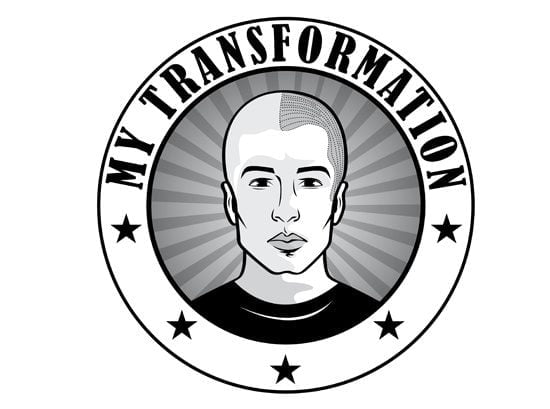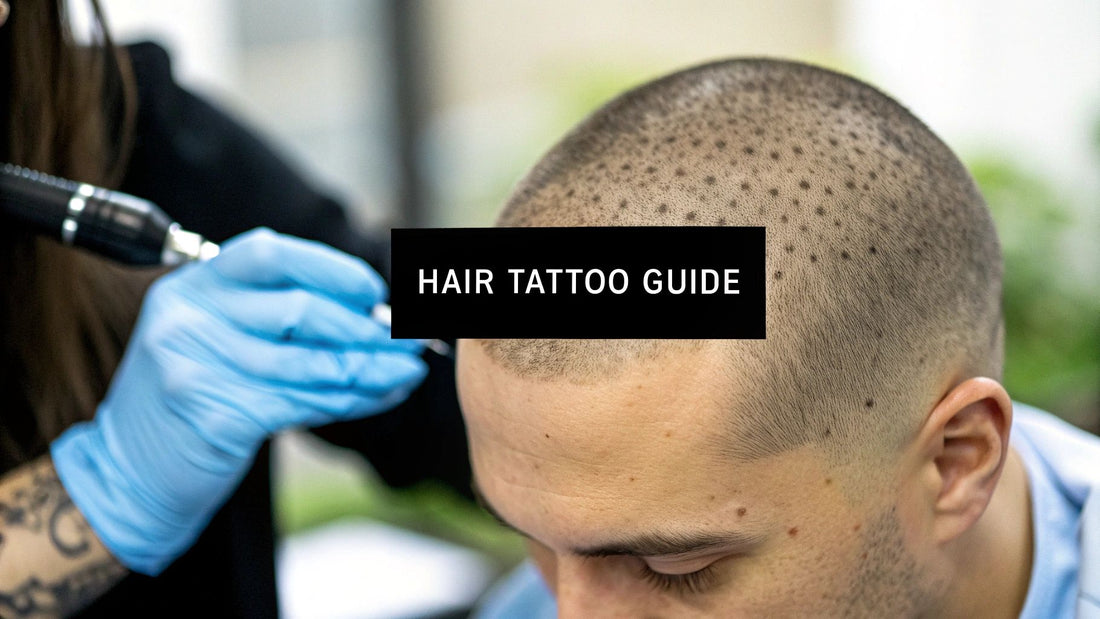
Hair Tattoo for Hair Loss An Australian Guide
Share
You've probably heard the term 'hair tattoo' and wondered what it's all about. Professionally, it’s known as Scalp Micropigmentation (SMP), and it's a clever, non-surgical solution that gives the look of thicker, fuller hair. It involves a trained practitioner using ultra-fine needles to place tiny dots of pigment onto the scalp, perfectly mimicking the appearance of individual hair follicles.
What Is a Hair Tattoo for Hair Loss?
Forget what you know about traditional body art. A hair tattoo is a completely different beast. It's a highly advanced form of cosmetic tattooing focused entirely on the scalp. Think of it less like a tattoo and more like an artistic technique called pointillism, where thousands of tiny, layered dots work together to create the illusion of a full head of hair that's been neatly shaved down.
This isn't about drawing lines or filling in areas with solid colour. It's a meticulous process where skilled practitioners use specialised equipment and pigments to match the precise size, shape, and colour of your natural hair follicles. The aim is always to create a seamless, undetectable blend with any hair you still have, giving you a completely natural finish.
The Illusion of Density
The real artistry of SMP is in how it builds the illusion of density and depth. It's not just one flat colour. A great practitioner will use several shades of pigment and carefully vary the placement and depth of the dots to build up layers, creating a convincing 3D effect.
This painstaking attention to detail is what sets a professional hair tattoo apart from a standard tattoo on the head. It's the difference between something that looks flat and drawn-on, and a result that's so realistic it can restore your confidence. For those interested in the finer points, you can find great information on professional SMP applications and techniques.
What SMP Achieves
One of the best things about SMP is its versatility. It can be tailored to tackle a whole range of hair loss issues, whether you're just starting to notice some thinning or are dealing with more advanced baldness.
Here are a few of its main uses:
- Creating a Buzz Cut Look: This is a game-changer for men with significant balding. SMP can create the look of a full, sharp buzz cut that looks intentional and stylish.
- Adding Density to Thinning Hair: For men and women experiencing thinning, SMP can be applied between the existing hairs. This reduces the noticeable contrast between your hair and scalp, making your hair appear instantly thicker.
- Camouflaging Scars: It’s also incredibly effective at concealing scars, whether they're from old hair transplant surgeries, accidents, or other procedures.
A hair tattoo is so much more than just pigment in the skin. It’s a carefully crafted illusion that restores the frame to your face and brings back the look of a natural hairline. You can learn more about how head tattoos for hair loss are transforming lives.
The Rise of Scalp Micropigmentation in Australia
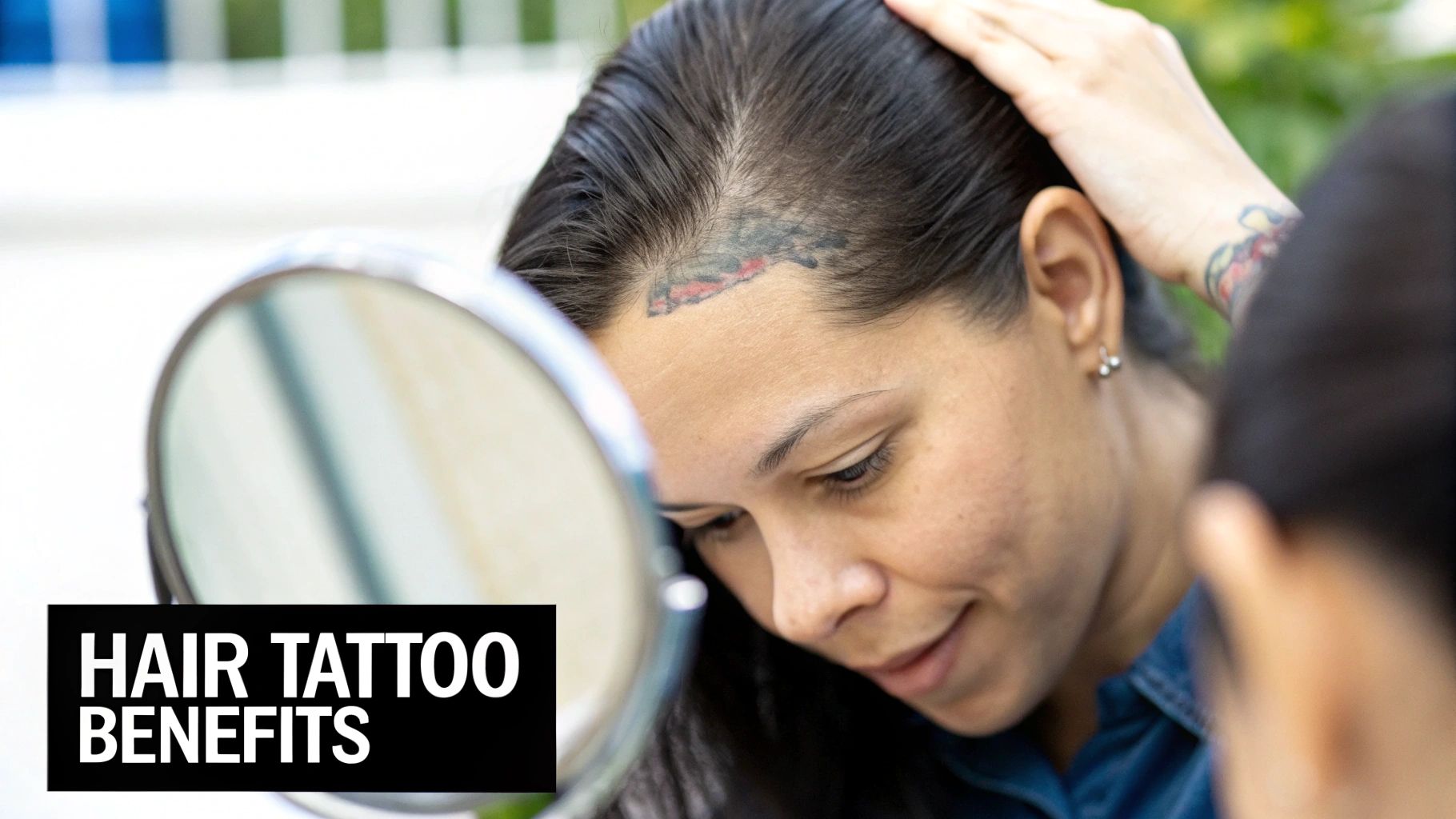
The hair tattoo is no longer some underground secret; it’s now a go-to solution for hair loss right across Australia. From busy clinics in Sydney and Melbourne to specialised studios in Perth, Scalp Micropigmentation (SMP) has seen a massive surge in popularity. This isn’t just a passing fad—it signals a real shift in how Aussies are tackling hair loss head-on.
Let's face it, many people are over the daily hassle of messy powders or fibres that don't always stay put. Others are sceptical about medications that come with ongoing costs, potential side effects, and often underwhelming results. This growing frustration with temporary fixes is exactly why so many are now looking for something more permanent and reliable.
A Practical Alternative to Invasive Surgery
When you think of permanent hair loss treatments, hair transplants are probably the first thing that comes to mind. But transplants are major surgery, and they come with a list of downsides that many Australians just aren't willing to accept. You need enough donor hair, the recovery time can be lengthy, and you might be left with visible scarring.
Then there's the price tag. A hair transplant in Australia can set you back anywhere from AUD 5,000 to over AUD 15,000, and there's no guarantee you'll get the density you were hoping for. SMP has emerged as a direct answer to this, offering a non-surgical and far more affordable path. For a lot of people, the choice is simple: they want a great result without the risks and expense of going under the knife. You can learn more about why a hair tattoo is the answer to hair loss in our in-depth guide.
Scalp Micropigmentation offers a real end to the daily battle with hair loss. It's a 'set and forget' solution that means you wake up every morning with a sharp, consistent hairline, free from the stress of hiding thinning patches.
Why SMP Is Gaining Momentum
The beauty of a hair tattoo for hair loss lies in its simplicity and effectiveness. When done by an experienced artist, it delivers instant, visible results that look completely natural. A few key factors are driving this trend:
- Predictable Outcomes: Unlike other treatments, you know exactly what you're getting with SMP. You and your practitioner design the precise hairline and density you want before you even begin.
- Minimal Maintenance: Once your sessions are done, the upkeep is incredibly simple. It's a low-fuss solution that fits easily into any lifestyle.
- Broad Suitability: SMP is effective for almost any stage of hair loss, works on different skin types, and is suitable for all ages, making it a genuinely accessible option.
This wave of interest has led to the rise of professional SMP providers in all major Australian cities. It’s a clear sign that people are looking for better alternatives to the old ways of dealing with hair loss, cementing the hair tattoo’s reputation as a top choice in the cosmetic industry.
Is a Hair Tattoo the Right Move for You?
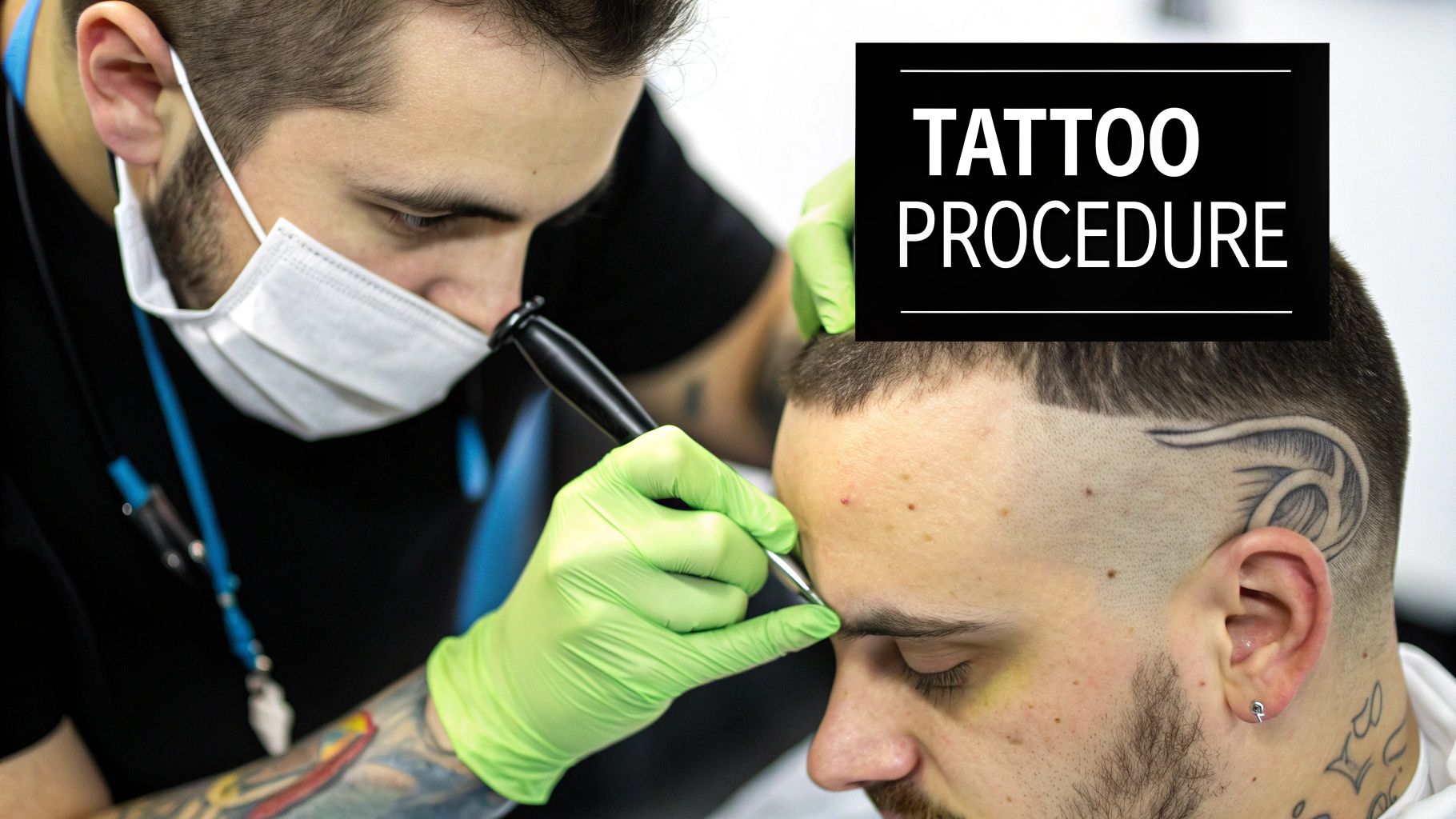
Deciding to get a hair tattoo is a big decision, and it’s natural to wonder if it’s the right path for you. The great thing about Scalp Micropigmentation (SMP) is its incredible versatility. It’s not a one-trick pony; it’s a sophisticated solution that can be adapted for many different types of hair loss.
Unlike a one-size-fits-all product, SMP is customised to your head, your hairline, and your specific goals. Of course, it's wise to explore all your options first. Many people start by looking into things like Japanese shampoos for hair loss just to see what's out there before committing to a procedure.
Who Is a Great Candidate for SMP?
So, who really gets the most out of a hair tattoo? SMP is a game-changer for people dealing with very specific hair loss issues who want a reliable, long-term fix.
You’re likely a perfect fit for SMP if you’re experiencing:
- Male Pattern Baldness: This is the classic scenario for SMP. It’s brilliant for crafting that sharp, clean-shaven buzz-cut look or meticulously rebuilding a hairline that’s started to recede.
- Diffuse Thinning: For men and women whose hair is thinning all over, SMP can work wonders. We can add density by placing pigment between your existing hairs, making the scalp far less visible and giving the illusion of a much fuller head of hair.
- Alopecia Areata: The patchy hair loss from this condition can be expertly camouflaged with SMP, restoring the appearance of even coverage and bringing back a ton of confidence.
- Scalp Scars: It's also an incredible tool for hiding scars, whether they’re from an old injury or a past hair transplant surgery (like FUT or FUE).
"SMP is about more than just aesthetics—it’s about reclaiming control. It gives you the power to proactively manage your appearance on your own terms, which can be incredibly empowering."
To make it even clearer, here’s a quick-glance table to help you see where SMP shines.
| SMP Suitability Snapshot | ||
|---|---|---|
| Hair Loss Condition | Is SMP a Good Solution? | Primary Benefit |
| General Thinning/Low Density | Yes | Creates the look of thicker, denser hair by reducing scalp contrast. |
| Receding Hairline | Yes | Rebuilds a natural, sharp, or soft hairline for a framed face. |
| Crown Balding | Yes | Fills in the balding area for a full, consistent buzz-cut appearance. |
| Alopecia Areata (Patchy Loss) | Yes | Camouflages bald patches, blending them seamlessly with existing hair. |
| Hair Transplant Scars (FUT/FUE) | Yes | Effectively conceals scars from previous surgical procedures. |
This table shows just how adaptable SMP can be, offering a real, visible solution for the most common hair loss concerns people face.
Who Might Need to Reconsider?
While SMP works for a huge range of people, it isn't a silver bullet for absolutely everyone. A good, ethical practitioner will always sit down with you for a proper consultation to make sure you’re a safe and suitable candidate.
There are a few situations where SMP might not be the best idea, at least not right away:
- Active Scalp Conditions: If you have severe psoriasis, dermatitis, or eczema on your scalp, you’ll need to get those conditions under control before having the treatment.
- Keloid Scarring: If your skin has a history of forming keloids (thick, raised scars), SMP might not be for you. The tiny punctures from the needle could potentially trigger new ones.
- Unrealistic Expectations: It's crucial to understand what SMP actually is. A hair tattoo creates the illusion of hair follicles; it doesn’t magically make hair grow back.
Ultimately, knowing what’s out there is key. If you’re still weighing things up, comparing a wig or a hair tattoo can help bring clarity to your decision. By being honest about your situation and what you hope to achieve, you can figure out with confidence if SMP is the right choice for you.
Your Step-by-Step SMP Journey
Getting SMP isn’t a one-and-done deal. Think of it more like an artist carefully building up layers on a canvas to create a masterpiece. It's a gradual process, and understanding what happens at each stage helps you know exactly what to expect, leaving you feeling confident from the first chat to the final reveal.
First things first, you'll need to book your consultation and treatment sessions. Many modern clinics use efficient online booking systems for hairdressers which makes scheduling everything a breeze.
The Initial Consultation and Design
Your journey kicks off with an in-depth consultation. This isn't just a quick chat; it's a crucial conversation where you'll talk through your hair loss history, your goals, and the look you're after. Now is the time to ask every single question you have on your mind.
During this meeting, your practitioner will take a close look at your scalp, skin tone, and any existing hair. The most important part? Designing your new hairline. A good artist won't just draw a generic line; they'll work with you to create a hairline that looks natural, suits your face shape, and is age-appropriate. Nothing proceeds until you are 100% happy with this design.
The First Session: Laying the Foundation
Consider the first treatment as laying down the blueprint. Your practitioner will use a lighter pigment to apply the very first layer of tiny dots across the treatment area. The goal here isn't to achieve the final look right away. It's all about establishing the foundational shape and creating a soft, subtle base of density.
This initial session sets the stage for what’s to come. Your scalp will need some time to heal, usually about 7-10 days, before you’re ready for the next layer. This healing time is vital for letting the pigment settle in properly.
Building Density and Detail in Subsequent Sessions
This is where the real magic happens. In your second and third sessions, the practitioner starts building on that foundation, adding layers of darker pigments and strategically varying the size and placement of the dots. This meticulous layering is what creates the incredibly realistic, three-dimensional illusion of actual hair follicles.
Each session builds upon the last, progressively increasing the density and adding intricate detail. This methodical approach ensures the final result is seamless, textured, and completely indistinguishable from a real buzz cut.
Once your final session is complete, proper aftercare is absolutely essential to protect your investment and lock in the best possible result. This infographic breaks down the simple, step-by-step process for looking after your new style.
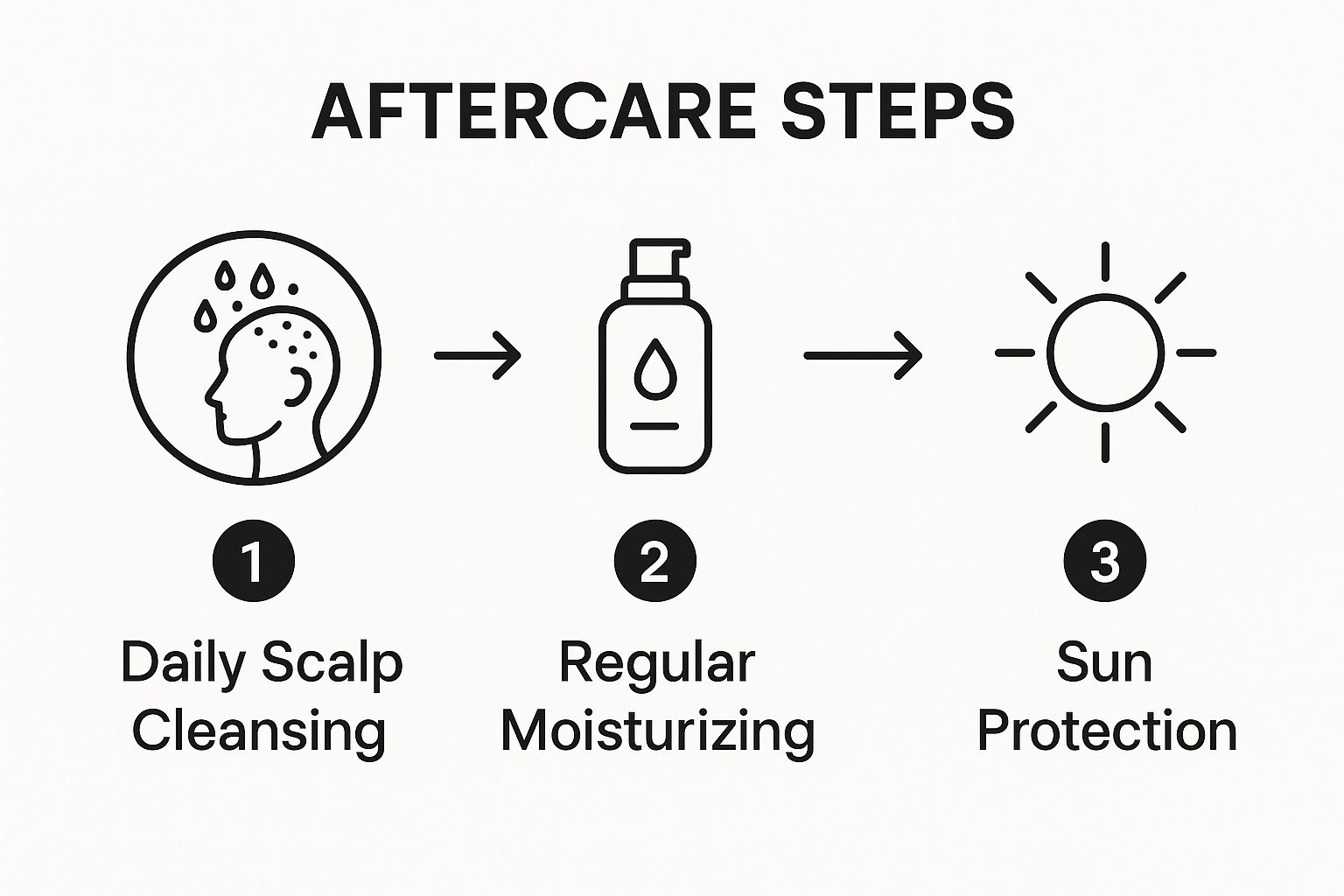
As the visual guide shows, consistent cleansing, moisturising, and sun protection are the cornerstones of great SMP care. For a deeper dive, check out our guide to https://www.mytransformation.com.au/blogs/news/scalp-micropigmentation-aftercare, which covers everything you need to know. By following this journey, you get more than just a restored hairline—you get your confidence back.
What It Costs and How to Care For It in Australia

Let's get straight to one of the biggest questions on everyone's mind: what's the price tag on a hair tattoo for hair loss? It’s helpful to think of Scalp Micropigmentation (SMP) as a one-off investment in your confidence. It’s not like creams or hair systems that hit your wallet again and again. SMP is an upfront cost for a lasting result.
In Australia, you can expect the price for a full course of SMP treatment to be anywhere from $1,200 to $4,000. That's a big range, I know. The final figure really comes down to the extent of your hair loss, how large the treatment area is, and the experience of your chosen clinic. Filling in a small patch to create density will be at the lower end, while treating a fully bald scalp will be at the higher end. For a more detailed breakdown, you can learn more about how much scalp micropigmentation costs and what influences the price.
The popularity of cosmetic tattooing is undeniable. The Australian tattoo industry, which SMP is part of, was valued at around AUD 37.16 million and is only expected to grow. This isn't just a fleeting trend; it shows a real shift in consumer confidence towards these kinds of aesthetic solutions. You can read more about the Australian tattoo market's growth on expertmarketresearch.com.au.
Protecting Your Investment with Smart Aftercare
After your final SMP session, the focus shifts to looking after it. Your practitioner will give you a clear set of instructions for the first week, and following them is vital for a great outcome. This usually means no heavy sweating, staying out of the sun, and not washing your scalp for a few days.
Getting through that initial healing period is the hardest part. After that, day-to-day care is incredibly simple and won’t disrupt your life at all.
Long-Term Habits to Keep Your SMP Looking Fresh
Keeping your hair tattoo looking sharp for years is far less hassle than dealing with daily hair loss products. The number one enemy of any tattoo pigment is the sun. To stop your SMP from fading, protecting it from UV rays has to be a non-negotiable part of your routine.
Here are a couple of simple habits that make all the difference:
- Use a Daily SPF Moisturiser: Make applying a moisturiser with at least SPF 30+ to your scalp a daily habit, just like brushing your teeth.
- Wear a Hat: If you're going to be out in the harsh Aussie sun for a while, a hat is your best friend. Simple as that.
Think of SMP touch-ups not as a problem, but as routine maintenance, like getting your car serviced. A quick session every 3-6 years is usually all it takes to refresh any minor fading and keep your results looking crisp and defined.
How Tattoos Becoming Mainstream Made Hair Tattoos a Go-To Solution
It's fascinating how the growing popularity of hair tattoos in Australia is directly linked to our culture's evolving attitude towards tattoos in general. What used to be a sign of rebellion is now just another way people express themselves, and that cultural shift has paved the way for procedures like Scalp Micropigmentation (SMP) to feel more like a practical choice than a radical one.
This normalisation has been a game-changer. When tattoos are everywhere, the basic idea of using needles to place pigment under the skin suddenly seems a lot less scary. It completely reframes how we think about SMP.
More Than Just Ink: A Practical Tool for Hair Loss
Instead of being seen as some extreme, last-ditch effort to deal with hair loss, the hair tattoo is now viewed as a smart and clever use of a familiar art form. People are simply more comfortable with the concept because the core technique is something they already understand and see every day.
Consider this: recent studies show that roughly 25% of Australians have at least one tattoo. That statistic alone shows just how common body art has become, creating an environment where cosmetic treatments using similar methods are met with curiosity rather than scepticism. You can dive deeper into these tattoo industry trends in Australia on ibisworld.com.
This social acceptance is a huge relief for anyone on the fence about SMP. It provides reassurance that they aren't making a strange or fringe decision. Instead, they're part of a broader trend where people are using modern aesthetic tools to feel better and more confident in their own skin.
The widespread acceptance of tattoos has built a cultural foundation for SMP to thrive. It lets people see the procedure not as a daunting medical process, but as a sophisticated grooming choice that offers a lasting solution to hair loss.
Your Hair Tattoo Questions, Answered
It's completely normal to have a few questions buzzing around in your head, even when you're feeling positive about a hair loss solution like SMP. Getting straight answers is the best way to feel truly confident and ready to move forward. Let’s walk through some of the most common things people ask before getting started.
What Does a Hair Tattoo Feel Like? Does It Hurt?
This is probably the number one question on everyone's mind, and the answer is usually a relief. Most of our clients describe the feeling as a minor annoyance rather than actual pain, typically rating it a 2 to 4 out of 10 on the pain scale.
It's far less intense than a regular tattoo. Why? Because the specialised needles we use are incredibly fine and only penetrate the very top layers of your skin. We also apply a strong topical numbing cream before we begin, making sure you're comfortable throughout the entire session.
How Do You Get the Right Hairline and Colour?
Achieving a look that's 100% natural is a collaborative art. We work together, combining your vision with our expertise, to design a result that looks like it was always meant to be there.
- Finding Your Colour: We don't just pick one shade. We custom-blend several pigments to perfectly match the tone of your existing hair and complement your unique skin undertones.
- Designing Your Hairline: Your practitioner will map out a soft, realistic, and age-appropriate hairline that suits your facial structure. We draw it on with a wax pencil first, giving you the final say before a single dot of pigment is applied. You are always in the driver's seat.
A great SMP artist won't move forward until you are completely happy with the proposed design. The aim is to create a look that enhances your features and feels authentically you.
Will My Hair Tattoo Look Fake?
When done correctly by a skilled and experienced specialist, an SMP treatment is virtually undetectable. People will notice you look better, but they won't be able to put their finger on why. The secret is in the details.
A true SMP professional uses multiple pigment shades and masterfully varies the size, angle, and depth of each micro-dot. This careful layering creates a subtle 3D effect that perfectly replicates the look of natural hair follicles. Always check an artist's portfolio of healed work to see their results for yourself—it’s the best way to find a clinic that delivers hyper-realistic outcomes.
Ready to see how a hair tattoo could change things for you? At My Transformation, Michael is dedicated to helping you find the perfect solution for your hair loss. Book your free consultation today and let's start the conversation.
